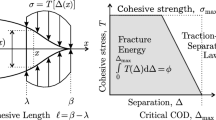Abstract
We present a new cohesive interface model for quasi-static creep crack growth that is implemented within a moving-grid finite element model. A pseudo crack tip separates the cohesive process zone from the free surfaces of the crack. The moving-grid formulation models continuous crack advance by describing relative motion between the pseudo crack tip and the material. This eliminates the need for extensive mesh refinement away from the current crack-tip location and supports both transient and direct steady-state solutions. A traction-separation law determines the energetic properties of the decohesion process and generates a simple criterion for crack advance. The new formulation remedies a problem in earlier models which permit a crack to heal on unloading. Numerical examples demonstrate the moving cohesive interface model in studies of steady-state crack growth. Adaptive grid refinement is used to control the accuracy of the solution.
Similar content being viewed by others
Author information
Authors and Affiliations
Rights and permissions
About this article
Cite this article
Carranza, F., Fang, B. & Haber, R. A moving cohesive interface model for fracture in creeping materials. Computational Mechanics 19, 517–521 (1997). https://doi.org/10.1007/s004660050202
Issue Date:
DOI: https://doi.org/10.1007/s004660050202




